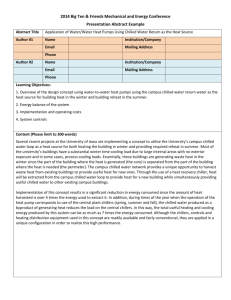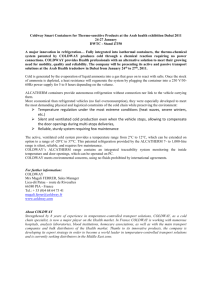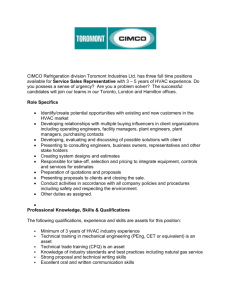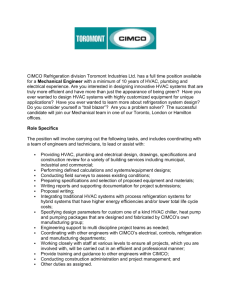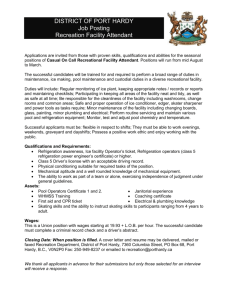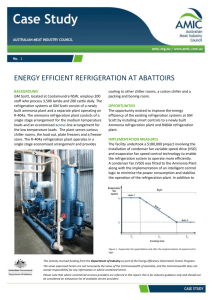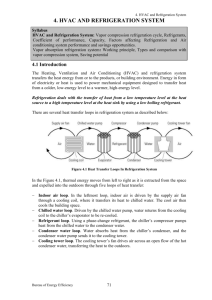MSU Chilled Water Plant Tour
advertisement
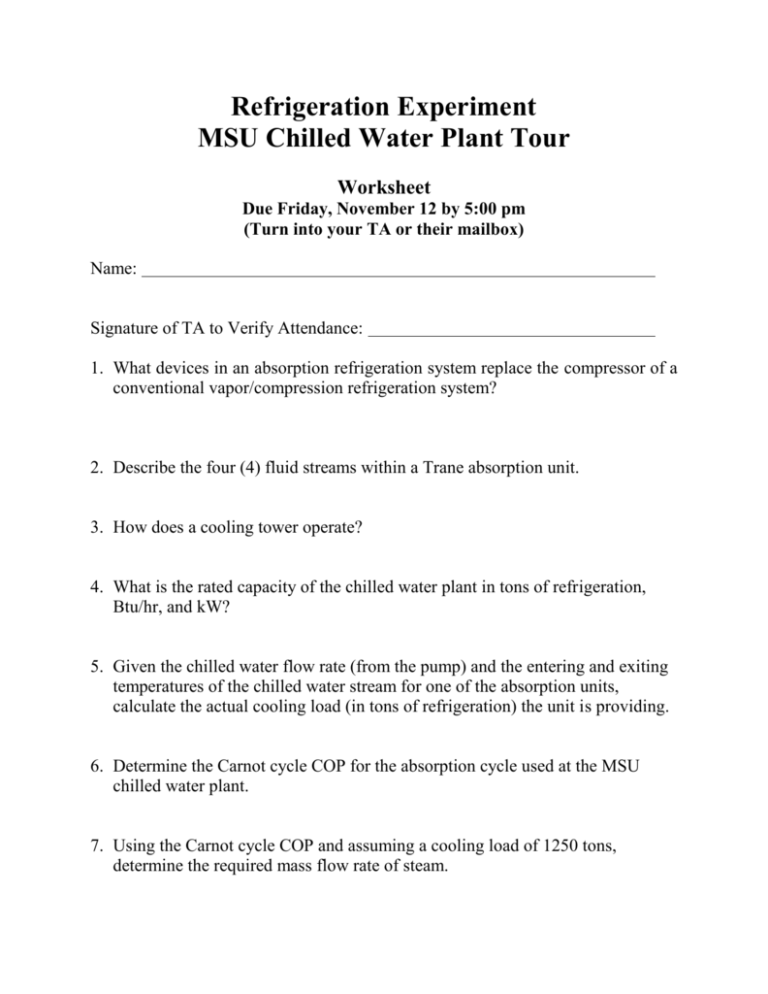
Refrigeration Experiment MSU Chilled Water Plant Tour Worksheet Due Friday, November 12 by 5:00 pm (Turn into your TA or their mailbox) Name: Signature of TA to Verify Attendance: 1. What devices in an absorption refrigeration system replace the compressor of a conventional vapor/compression refrigeration system? 2. Describe the four (4) fluid streams within a Trane absorption unit. 3. How does a cooling tower operate? 4. What is the rated capacity of the chilled water plant in tons of refrigeration, Btu/hr, and kW? 5. Given the chilled water flow rate (from the pump) and the entering and exiting temperatures of the chilled water stream for one of the absorption units, calculate the actual cooling load (in tons of refrigeration) the unit is providing. 6. Determine the Carnot cycle COP for the absorption cycle used at the MSU chilled water plant. 7. Using the Carnot cycle COP and assuming a cooling load of 1250 tons, determine the required mass flow rate of steam. MSU Chilled Water Plant Tour Lecture This experiment involves a tour of the main chilled water plant on campus and the completion of worksheet. The main chilled water plant is located on service road; just eat of the Service Rd-Bogue Rd intersection, as shown on the map overhead. The tours are scheduled for your regular lab times: November 2 (Tuesday) 3-5 PM November 4 (Thursday) 9:30-11:30 AM November 4 (Thursday) 1-3 PM You should meet at the plant and wear comfortable clothes and shoes. The tour will be given by Mike Crouch who is the lead refrigeration technician on campus. The worksheet consists of some questions about the plant operation and some simple calculations involving the plant. The purpose of a refrigeration system is the extraction of heat from a cold space, so as to maintain its cold temperature. Since the cold space is cold relative to its surrounding, this heat extraction normally involves driving heat in the direction opposite to its natural inclination. That is, a refrigeration system must "pump" heat from a region of low temperature to a region of high temperature. So as not to violate the second law of thermodynamics this pumping of heat requires a certain input of energy in the form of work or heat. A simple schematic of a refrigeration system acting thusly is shown below. High Temperature Heat Reservoir at TH QH Refrigerator QL Low Temperature Heat Reservoir at TL Wnet A refrigeration system generally works by using the fact that a phase change process is a very effective way of transferring heat. Hence, the interaction between the low temperature reservoir and the refrigerator is normally achieved with a evaporation phase change, whereas the interaction between the high temperature reservoir and the refrigerator involves a condensation phase change. Further, by adjusting the pressure the phase change process can be forced to occur at whatever temperature is appropriate and in whatever direction (evaporation or condensation) desired for the heat transfer. That is, in order to remove heat from a low temperature region, a fluid (the refrigerant) can be forced to boil at a low temperature by lowering the pressure so that energy can be absorbed from the cold space. Similarly, by boosting the pressure of the refrigerant when it is in contact with the warm environment it can be forced to condense and release the energy it absorbed from the cold space. The energy input is what controls the pressures. A measure of the operation of a refrigeration system is its COP. In general the COP is defined as COP = cooling effect required energy input In thermodynamics we learned that the most efficient refrigerator is a Carnot refrigerator that has COP max = 1 TH - 1 TL In a conventional vapor/compression refrigeration system, a compressor is used to control the refrigerant pressure and the required energy input is the work needed to run the compressor. Here on the MSU campus (as you found out during your tour of the Simon Power Plant), we have a cogeneration power facility that puts out both electric power and steam at 90 psig. The absorption refrigeration system is designed to utilize this steam as the required energy input and significantly reduce the electricity consumed for air conditioning on campus. Several buildings on campus are air conditioned with a chilled water system, where the chilled water is produced at a central plant on campus operating on the absorption refrigeration cycle. A schematic of this air conditioning system is shown below: Hot Air Warmed Water Air/Water Heat Exchanger Campus Building Cold Air Chilled Water Condensate Chilled Water Plant Steam Power Plant Steam In the absorption refrigeration cycle, the pressure is controlled by two devices called the generator and absorber instead of a compressor. The refrigerant is a Lithium/Bromide-Water solution. A unique phase equilibrium exists for this solution that connects the Li/Br concentration with the saturation temperature and pressure. By appropriately controlling the concentration the pressures of the condenser and evaporator can be controlled much in the same way a compressor controls them in a conventional vapor/compression refrigeration system. In order to maintain the appropriate concentration, energy must be added to the generator (via the steam, while the absorber must be maintained at a prescribed temperature and thus requires cooling. Water from the plants cooling tower provides both this cooling and the high temperature heat reservoir in the condenser. The system is shown in the schematic below. CONDENSER WATER OUT TO TOWER STEAM IN STEAM OUT CONDENSER GENERATOR HEAT EXCHANGER LOW PRESSURE WATER VAPOR CHILLED WATER IN ABSORBER CONDENSER WATER IN FROM TOWER CHILLED WATER OUT EVAPORATOR GENERATOR ABSORBER PUMP PUMP REFRIGERANT PUMP The cooling towers at the chilled water plant provide the heat rejection mechanism for the absorption system. Energy extracted from the chilled water is eventually deposited into the cooling tower water. This water then flows through the cooling tower where some of it evaporates into the air. This evaporation provides the mechanism to remove the energy from the cooling tower water. As we found with the power plant tour, the language of academia is very different form the language of industry. From our thermodynamics we would have considered the load of a refrigeration facility (the Q L) to be in kW. In industry the cooling load is given in tons of refrigeration. A ton of refrigeration is equivalent to the energy required to freeze one ton of water into ice in an hour. We can relate this unit to our more conventional units as follows 1 ton of refrigeration = 12,000 Btu/hr = 3.517 kW Also industry is much more concerned with the capacity of a system and that they are running at rated capacity than the COP of the system. Industry assumes that the system manufacturers have maximized the COP in their design and as users simply want the system to run at the capacity specified by the manufacturer. Review the worksheet, especially the calculations reminding the students of the 1 st Law of Thermodynamics. Figure 2. Schematic View of Trane Absorption Unit


